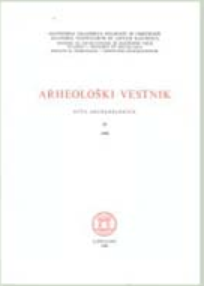Poznoantični staroselski grob iz Dan pri Starem trgu
Povzetek
Diggings in a sand quarry chanced upon a skeleton grave, which contained the following objects : several arm and leg bones, a pierced bronze coin, a little broken bronze bell, the damaged tongue of a bronze belt buckle, two bronze rings with attachments, the fragmented blade of an iron knife, a piece of the end of a bronze sheath and pieces of an oval ceramic pot with a grey-brown surface, bearing the impression of a wavy line and a horizontal, comb-like ornament. The grave lay 41 cm deep in a west-east direction.The contents of the grave reveal a certain typological inconsistency, which prevents the con[1]struction of a more exact chronological and ethnical picture. The bronze coin, which here served as an ornament, cannot be used as a means of dating the grave. It must be stressed that pierced coins appear in Slovenia mostly at the very end of the Roman period and later. Exceptionally they can also be found earlier. They are known especially from the period of the migration of nations2,3 and are very typical of the Belo Brdo culture.5 A similar case is presented by the iron knife, which can be traced through the late Roman period,6 but more often even later.’According to J. Korošec, by its shape our knife might even be Slavonic, as it has a narrow blade with a straight back, whose last part curved evenly towards the tip.10 How[1]ever, it is more probable that knives should only be considered together with more characteristic objects and not as independent material.9 Little bells are a known, if rare, find in Slovenia. They are most usually found in the Belo Brdo culture.13 Niederle characterizes them as a typical appendage to Slavonic dress.14 They can also be found in Austria during the same period, for example,15 and also during the first Avar Khanate (8th century) e. g. in Bačka Palanka.16 One example (possibly a button), made from plate silver, was found in the Dravlje cemetery, which belongs to the first half of the 6th century.17 Several exam[1]ples have also been found in Emona, although only in the settlement strata, etc.18 Amphora-shaped belt tongues are relatively very rare in Slovenia. Several examples of similar shape were discovered on Emona territory, but they have not yet been published.19 Analogous types may also be found in Intercisa20,21, Carnuntum, Salona and Aquileia and belong to the end of the 4th century and the period of transition into the 5th.22 The two bronze rings with attachments also seem to be part of a belt and such rings can as yet be traced only in prehistoric layers (Brezje, Vače, Vinkov vrh etc.).24,25 One example of a similar ring was also found in the female grave in Brakač in Istria, which probably belonged to the autochthonous population of the 7th or 8th cen[1]turies.26 In its workmanship, colour, decorative motifs and shape the ceramic pot reflects typical late[1]Roman autochthonous elements and has often been found in several sites in Slovenia.28 However it must be stressed that these elements are to a considerable degree characteristic of the autochtho[1]nous inventory of earthenware which can be traced from the early Roman period to the Middle Ages. At any event, we must range this pot among the material which is not typical of any chrono[1]logical classification. The material reflects late-Roman and later creative forces, although both are much impregnated with autochthonous traditions. Individual elements, such as the alignment of the grave, the pierced coin, the presence of a little bell in the grave and perhaps also the form of the knife, lead us towards a classification of the grave into the second half of the 5th or beginning of the 6th centuries. The ceramic pot, bronze rings and perhaps also the belt tongue could be regarded as objects in longer use, with prevailingly autochthonous elements. The lack of signs of the material culture of newly-arrived people indicates that the deceased belonged to the autochthonous population, either from already known Roman settlements (Šmarata, Ulaka) or from as yet unknown settlements around Dane.
Prenosi
Prenosi
Objavljeno
Kako citirati
Številka
Rubrike
Licenca

To delo je licencirano pod Creative Commons Priznanje avtorstva-Nekomercialno-Deljenje pod enakimi pogoji 4.0 mednarodno licenco.
Avtorji jamčijo, da je delo njihova avtorska stvaritev, da v njem niso kršene avtorske pravice tretjih oseb ali kake druge pravice. V primeru zahtevkov tretjih oseb se avtorji zavezujejo, da bodo varovali interese založnika ter da bodo povrnili morebitno škodo.
Podrobneje v rubriki: Prispevki





